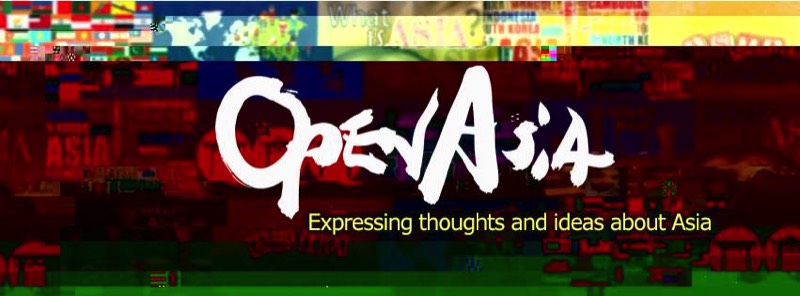Essays: PAHSA Hiroshima Short Program
As part of the PAHSA program, from 4-14 August 2013, the Graduate School for International Development and Cooperation (IDEC), Hiroshima University, hosted a two-week short-term study program on peace and human security for students from the Southeast Asia university consortium partners. After the program, students wrote short reports or essays detailing their experiences on the program. A selection of these works can be read below.
The Caution of Collective Memory: Why Japan’s 1947 Constitution is Worth Fighting for
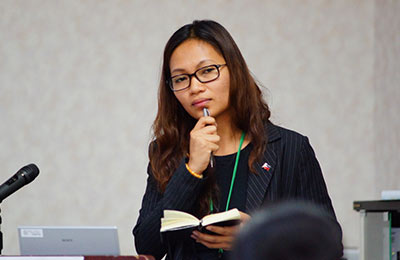
De La Salle University
@Hiroshima University
Reflections from the Hiroshima Short-term Study Program
The Japanese decision to adopt the Peace Constitution in 1947 began a long process of creating a collective memory for a ‘post-war Japan’. This historical milestone has since provided the mold that would change how Japanese citizens and the rest of the world perceive Japan: from a militaristic to a peace-loving state. Yet, critics of the Constitution claim that the country should seriously consider revising to adapt to the changing demands of both domestic and international politics.
The heart of this contention lies in the Article 9, which renounces the state’s sovereign right to use force and engage in war, thereby prohibiting the country’s Self-Defense Forces (SDF) from collective security measures. As if to prove the anachronistic nature of this provision, the ruling party, the Liberal Democratic Party (LDP), has consistently rallied against retaining it since 1955. Disputes include the question of Emperor Hirohito’s war guilt, Japan’s right to self-determination and its overall role in international security, to name a few. Recent examples would be Prime Minister Jun’ichiro Koizumi’s visits to the Yasukuni Shrine, his decision to deploy the SDF in Iraq in 2004 and current Prime Minister Shinzo Abe’s convening of the advisory panel to discuss lifting the ban on Japan’s self-defense right.
Even with LDP’s stance, war-renouncing Article 9 has enjoyed a fair acceptance from the international community, particularly from the neighboring countries of South Korea and China, who look at the peace provision as an apology for atrocities, dubbed as the “Asian Holocaust,” such as the Rape of Nanking, tortures and murders committed by the Japanese Imperial army during the war. After the Cold War, however, there was an increased pressure for Japan to play a more active role in international security. This clearly creates tension between the opposition and defenders of Article 9, which is considered as the most influential section of the Japanese constitution.
The heart of this contention lies in the Article 9, which renounces the state’s sovereign right to use force and engage in war, thereby prohibiting the country’s Self-Defense Forces (SDF) from collective security measures. As if to prove the anachronistic nature of this provision, the ruling party, the Liberal Democratic Party (LDP), has consistently rallied against retaining it since 1955. Disputes include the question of Emperor Hirohito’s war guilt, Japan’s right to self-determination and its overall role in international security, to name a few. Recent examples would be Prime Minister Jun’ichiro Koizumi’s visits to the Yasukuni Shrine, his decision to deploy the SDF in Iraq in 2004 and current Prime Minister Shinzo Abe’s convening of the advisory panel to discuss lifting the ban on Japan’s self-defense right.
Even with LDP’s stance, war-renouncing Article 9 has enjoyed a fair acceptance from the international community, particularly from the neighboring countries of South Korea and China, who look at the peace provision as an apology for atrocities, dubbed as the “Asian Holocaust,” such as the Rape of Nanking, tortures and murders committed by the Japanese Imperial army during the war. After the Cold War, however, there was an increased pressure for Japan to play a more active role in international security. This clearly creates tension between the opposition and defenders of Article 9, which is considered as the most influential section of the Japanese constitution.
The contest over Article 9
There are two arguments lodged for constitutional revision: First is the view that revision is an imperative response to the changing international political environment, especially with security threats from China and North Korea. The nationalists who seek for ‘normality’ in terms of assuming a political role in international relations, according to Samuels (2007;129), argues that the ‘statute of limitations for Japan’s mid-twentieth-century aggression expired long ago’. Equating normality to militarism, as what other country such as the United States and China are doing, the move to revise Article 9 can be assumed as bereft of any kind of politicized decision-making from the LDP because to choose otherwise would render Japan anomalous.
The second comes from those seeking for full sovereignty; this view holds that 1947 Constitution’s is an American-manufactured document forced on Japan during occupation (1945-1952). This view fervently holds that it is time for Japan to detach itself from the political goals of the United States and assume the sole responsibility of deciding for its own security, especially now that Japan is an economic power. This would of course, have huge implications with the US-Japan Peace Treaty of 1951. It is possible that a Japan with a strong military and the right to full sovereignty would rethink American use of bases in Okinawa. Based on these, the Japanese government thus appears to have the dual roles of an agent willing to sacrifice its long-standing postwar pacifist personality for the sake of adjusting to the international situation in the former, and a precursor of the long-sought independence of Japan from the US in the latter.
On the other side of the fence, those who oppose changes in the constitution appear to be the silent majority, especially compared to the political power the LDP has as the ruling party. While the Democratic Party of Japan (DPJ) has yet to communicate their stance on Article 9, the New Komeito fervently expresses its disapproval of changing it, with its chairman Natsuo Yamaguchi announcing the party’s willingness to act as a counterweight to the LDP if it endangers the peace clause of the Constitution. Whether they are using the Article 9 for political purposes or not, this view reflects the popular sentiment that sees the call for revision as a dangerous return to the status quo ante: an aggressive, warmonger Japan who deserved defeat and hatred from its victims during the war. The point, therefore, to retaining Article 9 is to preserve the pacifist identity and not risk a possible return to its bitter image overseas. This Japan has to believe that their pacifist and non-aggressive disposition would repel serious security threats from neighboring countries such as North Korea and China.
The second comes from those seeking for full sovereignty; this view holds that 1947 Constitution’s is an American-manufactured document forced on Japan during occupation (1945-1952). This view fervently holds that it is time for Japan to detach itself from the political goals of the United States and assume the sole responsibility of deciding for its own security, especially now that Japan is an economic power. This would of course, have huge implications with the US-Japan Peace Treaty of 1951. It is possible that a Japan with a strong military and the right to full sovereignty would rethink American use of bases in Okinawa. Based on these, the Japanese government thus appears to have the dual roles of an agent willing to sacrifice its long-standing postwar pacifist personality for the sake of adjusting to the international situation in the former, and a precursor of the long-sought independence of Japan from the US in the latter.
On the other side of the fence, those who oppose changes in the constitution appear to be the silent majority, especially compared to the political power the LDP has as the ruling party. While the Democratic Party of Japan (DPJ) has yet to communicate their stance on Article 9, the New Komeito fervently expresses its disapproval of changing it, with its chairman Natsuo Yamaguchi announcing the party’s willingness to act as a counterweight to the LDP if it endangers the peace clause of the Constitution. Whether they are using the Article 9 for political purposes or not, this view reflects the popular sentiment that sees the call for revision as a dangerous return to the status quo ante: an aggressive, warmonger Japan who deserved defeat and hatred from its victims during the war. The point, therefore, to retaining Article 9 is to preserve the pacifist identity and not risk a possible return to its bitter image overseas. This Japan has to believe that their pacifist and non-aggressive disposition would repel serious security threats from neighboring countries such as North Korea and China.
Article 9 as historical mnemonic
Juxtapose these two views and one will see that both opposing arguments revolve around the same realist lens of state-centeredness particularly when it comes to power and security. Aside from the fact that revision would give the LDP a lopsided favor over popular sentiments, increasing power through militarization would also be counterintuitive to Japan’s efforts of correcting historical wrongs and getting support from its emotionally-charged citizens. More importantly, in both perspectives, the paradox presents itself with the harsh reality that if indeed Japan wanted to exercise its full sovereignty, this could be another instance of kowtowing to external demands rather than deciding on its own.
This is not to say that having the Peace Constitution, given its US-influenced origins, was a wrong decision. If anything else, this Constitution aligns Japan to international norms. It has actually saved the country from further enmity and damage as a result of the war. The point is, unlike other countries such as Germany and the United States that openly acknowledge militaristic acts in the past with deep apologies for their victims, Japan is still in the process of admitting fault for its brutal war activities.
However, refusing to change the Constitution means that the government is unable to fulfill its responsibility of guaranteeing security of both its people and the international community, especially with threats from China and North Korea being hard to ignore. Not to mention the potential of Japan to assume a leadership role in the region. In short, choosing to argue in the realist fashion would place Japan in a precarious situation with either choices giving them the optimal result of achieving power and security.
What must then be considered is interpreting Article 9 not just a state security apparatus, but also an historical mnemonic that institutionalized Japanese pacifist identity by serving as the guiding principle of Japan’s domestic and international policy in the postwar era.
Collective memory of a nation is created to build political consensus on how the nation’s past is interpreted through elements of the present. The state can thus use collective memory to institutionalize an ‘imagined political community’ through historiography, mass communication and education. Manifestations of collective memory can be found in both formal and informal forms, such as laws and declarations in the former and museums or survivors’ accounts on the other. Combined, they form a particular form of collective ‘national’ identity. And, in the efforts to forge a collective identity, how people remember historical events becomes the basis of the narratives from which people identify themselves. No other country would value collective memory more than Japan, where deep contestations of interpretations of history are still left unconcluded.
This is not to say that having the Peace Constitution, given its US-influenced origins, was a wrong decision. If anything else, this Constitution aligns Japan to international norms. It has actually saved the country from further enmity and damage as a result of the war. The point is, unlike other countries such as Germany and the United States that openly acknowledge militaristic acts in the past with deep apologies for their victims, Japan is still in the process of admitting fault for its brutal war activities.
However, refusing to change the Constitution means that the government is unable to fulfill its responsibility of guaranteeing security of both its people and the international community, especially with threats from China and North Korea being hard to ignore. Not to mention the potential of Japan to assume a leadership role in the region. In short, choosing to argue in the realist fashion would place Japan in a precarious situation with either choices giving them the optimal result of achieving power and security.
What must then be considered is interpreting Article 9 not just a state security apparatus, but also an historical mnemonic that institutionalized Japanese pacifist identity by serving as the guiding principle of Japan’s domestic and international policy in the postwar era.
Collective memory of a nation is created to build political consensus on how the nation’s past is interpreted through elements of the present. The state can thus use collective memory to institutionalize an ‘imagined political community’ through historiography, mass communication and education. Manifestations of collective memory can be found in both formal and informal forms, such as laws and declarations in the former and museums or survivors’ accounts on the other. Combined, they form a particular form of collective ‘national’ identity. And, in the efforts to forge a collective identity, how people remember historical events becomes the basis of the narratives from which people identify themselves. No other country would value collective memory more than Japan, where deep contestations of interpretations of history are still left unconcluded.
Collective memory as state identity
One thing is clear: collective memory has been an important pillar in creating Japan’s anti-war state identity. For whatever shall be the basis of these opinions if not for what and how they were taught to remember and make the past matter in the present? This path-dependence posed by the creation of a collective memory refuses to be ignored, especially when its subjects are continuously confronted with reminders from peace ceremonies, declarations, museums to simple narratives delivered by A-bomb survivors (hibakusha), that indeed tell how history is to be remembered. These reminders have and continually press an internalized importance among the citizens and the rest of the world.
What if this collective-memory-as-state-identity is that thing that keeps Japan’s enemies from actually attacking? How can the government win over this collective memory, which it institutionalized and probably has gained more legitimacy than itself who are the creators? More importantly, what awaits practices of collective memory if they are not aligned with the Constitution?
What the current support for the revising the “peace provision” sorely misses is the potential of collective memory as the most compelling basis of state identity, and even security. Because collective memory has gone through the process of being owned by those who are part of the history and those remembering, disregarding collective memory in favor of a realistic response to the so-called demands of international politics can be perilous to Japan’s state identity. Since the process of shaping history through representational practices of collective memory is intimately related to how the state establishes its identity, it will be difficult for the government to revise Article 9 devoid of serious interrogation from both its citizens and the international community.
Ultimately, any attempt to revise this provision would not only derange Japan’s security situation, but more importantly, would dislodge practices of commemoration for the past 60 years as merely tokenistic. That would seriously fracture the very core of Japan’s state identity.
What if this collective-memory-as-state-identity is that thing that keeps Japan’s enemies from actually attacking? How can the government win over this collective memory, which it institutionalized and probably has gained more legitimacy than itself who are the creators? More importantly, what awaits practices of collective memory if they are not aligned with the Constitution?
What the current support for the revising the “peace provision” sorely misses is the potential of collective memory as the most compelling basis of state identity, and even security. Because collective memory has gone through the process of being owned by those who are part of the history and those remembering, disregarding collective memory in favor of a realistic response to the so-called demands of international politics can be perilous to Japan’s state identity. Since the process of shaping history through representational practices of collective memory is intimately related to how the state establishes its identity, it will be difficult for the government to revise Article 9 devoid of serious interrogation from both its citizens and the international community.
Ultimately, any attempt to revise this provision would not only derange Japan’s security situation, but more importantly, would dislodge practices of commemoration for the past 60 years as merely tokenistic. That would seriously fracture the very core of Japan’s state identity.
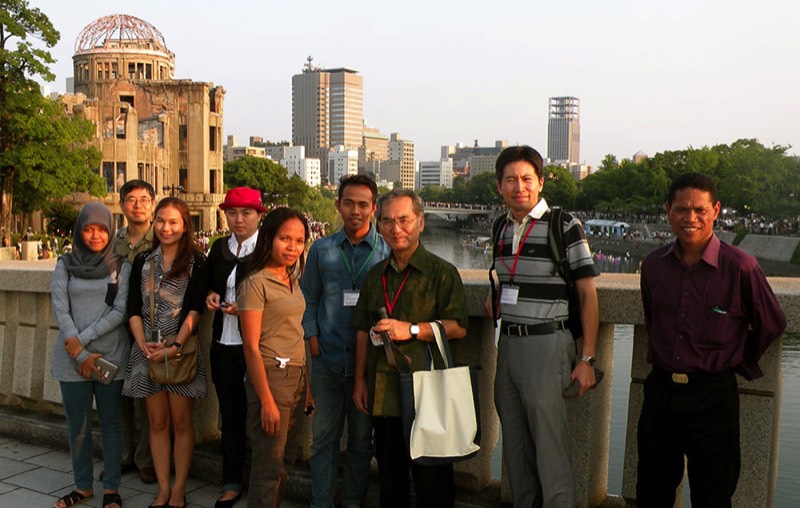
PAHSA students Southeast Asia and Japanese professors are pictured with Hiroshima Peace Memorial in the background
The Role of Tara Bandu in Conflict Transformation in Timor-Leste
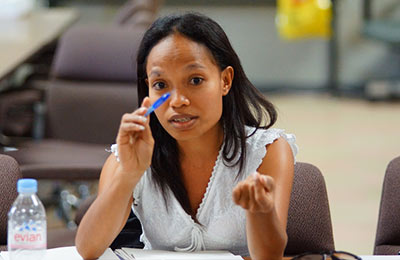
Universidade Nacional Timor-Lorosa’e
@Hiroshima University
On a field trip as part of the Hiroshima short-term program I learned something important when visiting Miyajima Island in Hiroshima. It became clear to me that its people celebrate their beliefs as an intrinsic part of their culture. This is seen in activities such as the bi-annual Fire Walking Ritual where monks walk through the coals of flames to bring good fortune to worshippers. There’s also the Goma ritual. In another fiery ceremony using Acala as the principal image, the deity’s power is enlisted to bring peace and prosperity for all people as well as for the productivity of grain. Traditions such as these have been kept alive for at least 3,600 years since the age of Vedas (the late bronze age) and probably longer. Carried away with the religious pyrotechnics, a casual onlooker from overseas might miss the deeper cultural significance that events like these have for many Japanese people.
Currently, Timor-Leste, my birthplace, is promoting its own cultural mechanism to resolve violence and conflict. It is hoped that through the power of culture and belief, the Timorese could fight for liberation and courageously defend Timor-Leste from forms of foreign occupation. This traditional cultural mechanism is called Tara Bandu. Tara Bandu comprises of traditional laws based on spiritual beliefs that set out community accords in many of Timor-Leste’s tribal or cultural groups. Historically, Tara Bandu was used, during both the periods of Portuguese colonial and Indonesian military occupation, as a means to enforce local governance systems and control the population. Since Timor-Leste’s vote for Independence in 1999, Tara Banduhas enjoyed resurgence, particularly since the 2006 military crisis.
Many community issues are addressed through this traditional practice, including agreements aimed at bringing end to conflict. Unfortunately the actual effectiveness of the traditional process is not guaranteed. A variety of factors contribute to the success or failure of community accords.
Currently, Timor-Leste, my birthplace, is promoting its own cultural mechanism to resolve violence and conflict. It is hoped that through the power of culture and belief, the Timorese could fight for liberation and courageously defend Timor-Leste from forms of foreign occupation. This traditional cultural mechanism is called Tara Bandu. Tara Bandu comprises of traditional laws based on spiritual beliefs that set out community accords in many of Timor-Leste’s tribal or cultural groups. Historically, Tara Bandu was used, during both the periods of Portuguese colonial and Indonesian military occupation, as a means to enforce local governance systems and control the population. Since Timor-Leste’s vote for Independence in 1999, Tara Banduhas enjoyed resurgence, particularly since the 2006 military crisis.
Many community issues are addressed through this traditional practice, including agreements aimed at bringing end to conflict. Unfortunately the actual effectiveness of the traditional process is not guaranteed. A variety of factors contribute to the success or failure of community accords.
What is Tara Bandu?
Tara Bandu codes of behavior continue to be established in conflict-prone areas in post-conflict Timor-Leste. There is a widely held view that Tara Bandu refers to a traditional Timorese custom that enforces peace and reconciliation through the power of public agreement to define social norms and practices acceptable to a given community. It is one aspect of “customary practice” or “lisan” in Timor-Leste, a “broad term encompassing local law, social norms and morality, art and rituals, and a system of community leadership and governance.” Communities define Tara Bandu as a traditional and common practice with the means to reduce or prevent community conflict, reduce crime, protect the environment, manage natural resources and improve community welfare.
Tara Bandu involves the hanging of culturally significant items from a wooden shaft to place a ban on certain agricultural or social activities within a given area. The people believe that someone who violates the prohibition set by Tara Bandu will be cursed. Fear of affliction facilitates strong compliance with the regulations implemented by customary leaders. Core leadership for the practice of Tara Bandu customary law is taken by the Lia Na’in, a descendant of a chief of a traditional tribe. A respected individual within the community, the Lia Na’in enforces proper treatment of nature by drawing on accumulated local knowledge. He takes a key role in the supernatural aspects of the Tara Bandu mechanism and in maintaining order for rituals.
Tara Bandu regulates ‘people-to-people’ relations in socio-cultural, economic and political interactions. Its application within the socio-cultural aspect specifies that people cannot violate other people’s ‘rights’ (as understood by those designing the Tara Bandu and not necessarily human rights as defined by the law). Violations include committing physical or sexual violence, theft, and property destruction. In economic interactions, Tara Bandu can prohibit people from committing infractions and wasteful spending that could affect people’s livelihoods and might lead to family conflict. Tara Bandu can also regulate political behavior, including placing restrictions on people using provocative language or insults about others’ political views.
The Tara Bandu could bring people together as one family to find a good solution for their problem through the mediation called “Nahe Biti” that uses the traditional way of justice. The solution concluded by Nahe Biti becomes sustainable because the Lia Na’in, as mediator, also fully understands his/her community and the root of problems.
Tara Bandu involves the hanging of culturally significant items from a wooden shaft to place a ban on certain agricultural or social activities within a given area. The people believe that someone who violates the prohibition set by Tara Bandu will be cursed. Fear of affliction facilitates strong compliance with the regulations implemented by customary leaders. Core leadership for the practice of Tara Bandu customary law is taken by the Lia Na’in, a descendant of a chief of a traditional tribe. A respected individual within the community, the Lia Na’in enforces proper treatment of nature by drawing on accumulated local knowledge. He takes a key role in the supernatural aspects of the Tara Bandu mechanism and in maintaining order for rituals.
Tara Bandu regulates ‘people-to-people’ relations in socio-cultural, economic and political interactions. Its application within the socio-cultural aspect specifies that people cannot violate other people’s ‘rights’ (as understood by those designing the Tara Bandu and not necessarily human rights as defined by the law). Violations include committing physical or sexual violence, theft, and property destruction. In economic interactions, Tara Bandu can prohibit people from committing infractions and wasteful spending that could affect people’s livelihoods and might lead to family conflict. Tara Bandu can also regulate political behavior, including placing restrictions on people using provocative language or insults about others’ political views.
The Tara Bandu could bring people together as one family to find a good solution for their problem through the mediation called “Nahe Biti” that uses the traditional way of justice. The solution concluded by Nahe Biti becomes sustainable because the Lia Na’in, as mediator, also fully understands his/her community and the root of problems.
Tara Bandu rituals
Communities are keen to promote Tara Bandu as a public form of community consultation, which is particularly important in addressing civil conflict cases; criminal cases are not addressed under the practice. At a Tara Bandu ceremony, the communities customarily come together to celebrate the ritual ceremony and promise that they will live together as one family with harmony without violence. At the same time, they agree to comply with the Tara Bandu law and any sentence that will be written and signed.
The sequence of the Tara Bandu ceremony is as follows: First, representatives of all opposing groups read out parts of the peace pact or the Tara Bandu regulations. Then, each leader signs the peace pact as witnesses (local leaders/national leaders). Second, the sanctification of the sacrificial animals and materials takes place while the women are dancing and singing. Third, slaughter of the sacrificial animals is done one by one; the blood is collected in a coconut shell. Fourth, the leaders of opposing groups drink the blood to signify that they have become brothers that will work together as one spirit with unity. Fifth, the traditional leader and his team examine the insides of the slaughtered animals (heart, intestine, liver, lungs, etc.) the parts people believe to predict if these offerings will bring peace to the community, or to foretell more challenges for peace in the future. Sixth, all participants accompany the traditional leader and opposing groups take the offerings - parts of the animals like horn, claws, chicken heads, tails, feet, etc.) and hang on the sacred wood. And finally, the traditional leader’s team cleans and boils the meat. Once it is cooked, everyone present eats a piece or two.
The sequence of the Tara Bandu ceremony is as follows: First, representatives of all opposing groups read out parts of the peace pact or the Tara Bandu regulations. Then, each leader signs the peace pact as witnesses (local leaders/national leaders). Second, the sanctification of the sacrificial animals and materials takes place while the women are dancing and singing. Third, slaughter of the sacrificial animals is done one by one; the blood is collected in a coconut shell. Fourth, the leaders of opposing groups drink the blood to signify that they have become brothers that will work together as one spirit with unity. Fifth, the traditional leader and his team examine the insides of the slaughtered animals (heart, intestine, liver, lungs, etc.) the parts people believe to predict if these offerings will bring peace to the community, or to foretell more challenges for peace in the future. Sixth, all participants accompany the traditional leader and opposing groups take the offerings - parts of the animals like horn, claws, chicken heads, tails, feet, etc.) and hang on the sacred wood. And finally, the traditional leader’s team cleans and boils the meat. Once it is cooked, everyone present eats a piece or two.
The government of Timor-Leste has recognized the significance of customary law and gives emphasis to its importance in several procedures and regulations. It is initiated by underlining the value of customs in the Timor-Leste Constitution. The RDTL Constitution of Article 4 declaims: “The State shall recognize and value the norms and customs of Timor-Leste that not are contrary to the Constitution and to any legislation dealing specifically with customary law.”
Like the Fire Walking and Goma ceremony in Japan, Tara Bandu in Timor-Leste has a deep significance for its people, only in Timor-Leste, its influence is felt by communities in the resolution of disputes. Respected, trusted, and passed down from generation to generation, these rituals are performed for peace —peace for societies, the nation and a conflict-free life.
Like the Fire Walking and Goma ceremony in Japan, Tara Bandu in Timor-Leste has a deep significance for its people, only in Timor-Leste, its influence is felt by communities in the resolution of disputes. Respected, trusted, and passed down from generation to generation, these rituals are performed for peace —peace for societies, the nation and a conflict-free life.
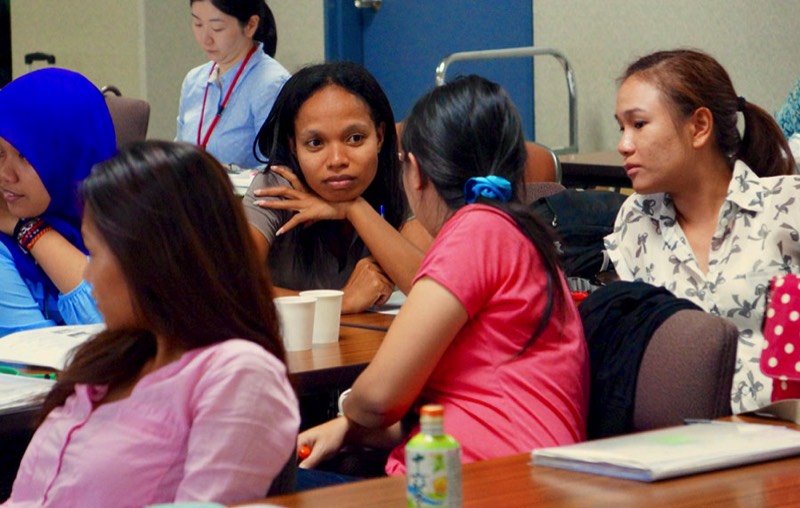
Classroom discussion at the conclusion of one of the lectures on the PAHSA Short Program
The Role of Security Dialogue in Forging Durable Peace in Northeast Asia
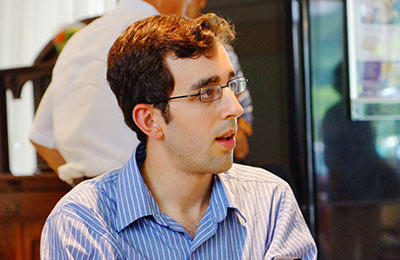
Nanyang Technological University, Singapore
@Hiroshima University
There have been no major military conflicts in Northeast Asia since the 1953 armistice of the Korean War. However, in the sixty years since, multiple incidents have occurred which could have led to military escalation and human suffering. I believe that in the absence of durable security dialogue mechanisms and robust confidence-building measures between the security actors of Northeast Asia, the relatively peaceful status quo will not long endure.
It is first necessary to define which countries are key participants in a Northeast Asia security dialogue process. The obvious candidates are Japan, South Korea, China, Russia and the United States. Potential observers are North Korea and Taiwan.
In the last several years, particularly since 2010, military tensions have spiked in Northeast Asia. This is due to a spate of incidents such as the sinking of the Cheonan, the shelling of Yeonpyeong Island, a February 2013 North Korean nuclear test, and assertiveness at sea and in the skies near the Senkaku/Diaoyu Islands.
Amidst the backdrop of these tense regional security dynamics, other developments have occurred which impact Northeast Asian security. The United States announced its “rebalancing” or pivot to Asia in the middle of the first Obama presidential term and looks set to continue this diplomatic, economic, and military shift in emphasis. In addition, the Chinese military has continued to modernize and grow its defense budget. Japan recently announced its intention to raise its defense budget. The population of South Korea is supportive of developing an indigenous nuclear weapons capability.
The countries of Northeast Asia have flourishing economic ties, but their ties in the security realm are extremely weak. Quarrels over historical interpretation and territory, which are magnified by a climate of strategic mistrust and surges of nationalism, all inhibit closer cooperation on the security front.
However, there is hope for a more peaceful future if leaders in Northeast Asian countries are willing to exert political will to begin an official, Track 1 security dialogue process. Such efforts already occur on a Track 1.5 and Track 2 basis. The costs of such a process would be low and the potential benefits high.
The participants in such a process resemble the composition of the Six-Party Talks, though the North Korean nuclear issue should not be the only agenda item. Instead, an inclusive dialogue process held regularly in rotating capitals with an atmosphere that promotes candor will reduce the risks of conflict breaking out in Northeast Asia. Foreseeable deliverables could include the signing of a Northeast Asia Incidents at Sea Agreement, the establishment of hotlines for crisis communications where they do not already exist, and the clarification of strategic intentions.
Northeast Asia suffers from a lack of strong security institutions. There is no sub-regional NATO. The U.S. “hub and spokes” alliance system, in particular its bilateral security guarantees with Japan and South Korea, has been the defining feature of Northeast Asian security since the end of World War II. Although the alliances remain strong, they are not sufficient in and of themselves to confront the range of challenges facing Northeast Asian security actors.
The possibility of conflict, whether accidental or deliberate, remains in Northeast Asia. Plausible scenarios include a North Korean missile falling on South Korean or Japanese territory, a Japan-China clash near the Senkaku/Diaoyu Islands, or a U.S.-China confrontation. Crisis contingency planning for instability in North Korea among all concerned parties has not yet occurred. Any one of these serious security risks would justify an official Northeast Asian security dialogue process, though the existence of numerous risks necessitates a robust dialogue.
The security agenda extends beyond traditional security issues to nontraditional and human security. The three largest economies in the world – the U.S., China, and Japan – are in Northeast Asia. Instability in Northeast Asia would have a major impact on countries worldwide. Energy security, human trafficking, food security, and a host of other issues are threats to stability in Northeast Asia.
It is true that several institutional mechanisms already exist that include Northeast Asian security actors such as the ASEAN Regional Forum (ARF) launched in 1994 and the ASEAN Defense Ministers Meeting Plus (ADMM-Plus) begun in 2010. Although these institutions can further peace in Asia, their memberships are too large to confront issues that specifically impact the fate of Northeast Asia. An excessive focus on Northeast Asian issues by the ARF or ADMM-Plus could alienate other member states. In other words, a Northeast Asian security dialogue process could complement and potentially feed into existing institutions with wider memberships.
Security dialogue in Northeast Asia will not be a panacea to the latent tensions in the region. However, all parties in Northeast Asia desire a peaceful and prosperous future for their people. This future will only be possible if proactive steps are taken to prevent military confrontation, which would create terrible human costs.
It is first necessary to define which countries are key participants in a Northeast Asia security dialogue process. The obvious candidates are Japan, South Korea, China, Russia and the United States. Potential observers are North Korea and Taiwan.
In the last several years, particularly since 2010, military tensions have spiked in Northeast Asia. This is due to a spate of incidents such as the sinking of the Cheonan, the shelling of Yeonpyeong Island, a February 2013 North Korean nuclear test, and assertiveness at sea and in the skies near the Senkaku/Diaoyu Islands.
Amidst the backdrop of these tense regional security dynamics, other developments have occurred which impact Northeast Asian security. The United States announced its “rebalancing” or pivot to Asia in the middle of the first Obama presidential term and looks set to continue this diplomatic, economic, and military shift in emphasis. In addition, the Chinese military has continued to modernize and grow its defense budget. Japan recently announced its intention to raise its defense budget. The population of South Korea is supportive of developing an indigenous nuclear weapons capability.
The countries of Northeast Asia have flourishing economic ties, but their ties in the security realm are extremely weak. Quarrels over historical interpretation and territory, which are magnified by a climate of strategic mistrust and surges of nationalism, all inhibit closer cooperation on the security front.
However, there is hope for a more peaceful future if leaders in Northeast Asian countries are willing to exert political will to begin an official, Track 1 security dialogue process. Such efforts already occur on a Track 1.5 and Track 2 basis. The costs of such a process would be low and the potential benefits high.
The participants in such a process resemble the composition of the Six-Party Talks, though the North Korean nuclear issue should not be the only agenda item. Instead, an inclusive dialogue process held regularly in rotating capitals with an atmosphere that promotes candor will reduce the risks of conflict breaking out in Northeast Asia. Foreseeable deliverables could include the signing of a Northeast Asia Incidents at Sea Agreement, the establishment of hotlines for crisis communications where they do not already exist, and the clarification of strategic intentions.
Northeast Asia suffers from a lack of strong security institutions. There is no sub-regional NATO. The U.S. “hub and spokes” alliance system, in particular its bilateral security guarantees with Japan and South Korea, has been the defining feature of Northeast Asian security since the end of World War II. Although the alliances remain strong, they are not sufficient in and of themselves to confront the range of challenges facing Northeast Asian security actors.
The possibility of conflict, whether accidental or deliberate, remains in Northeast Asia. Plausible scenarios include a North Korean missile falling on South Korean or Japanese territory, a Japan-China clash near the Senkaku/Diaoyu Islands, or a U.S.-China confrontation. Crisis contingency planning for instability in North Korea among all concerned parties has not yet occurred. Any one of these serious security risks would justify an official Northeast Asian security dialogue process, though the existence of numerous risks necessitates a robust dialogue.
The security agenda extends beyond traditional security issues to nontraditional and human security. The three largest economies in the world – the U.S., China, and Japan – are in Northeast Asia. Instability in Northeast Asia would have a major impact on countries worldwide. Energy security, human trafficking, food security, and a host of other issues are threats to stability in Northeast Asia.
It is true that several institutional mechanisms already exist that include Northeast Asian security actors such as the ASEAN Regional Forum (ARF) launched in 1994 and the ASEAN Defense Ministers Meeting Plus (ADMM-Plus) begun in 2010. Although these institutions can further peace in Asia, their memberships are too large to confront issues that specifically impact the fate of Northeast Asia. An excessive focus on Northeast Asian issues by the ARF or ADMM-Plus could alienate other member states. In other words, a Northeast Asian security dialogue process could complement and potentially feed into existing institutions with wider memberships.
Security dialogue in Northeast Asia will not be a panacea to the latent tensions in the region. However, all parties in Northeast Asia desire a peaceful and prosperous future for their people. This future will only be possible if proactive steps are taken to prevent military confrontation, which would create terrible human costs.
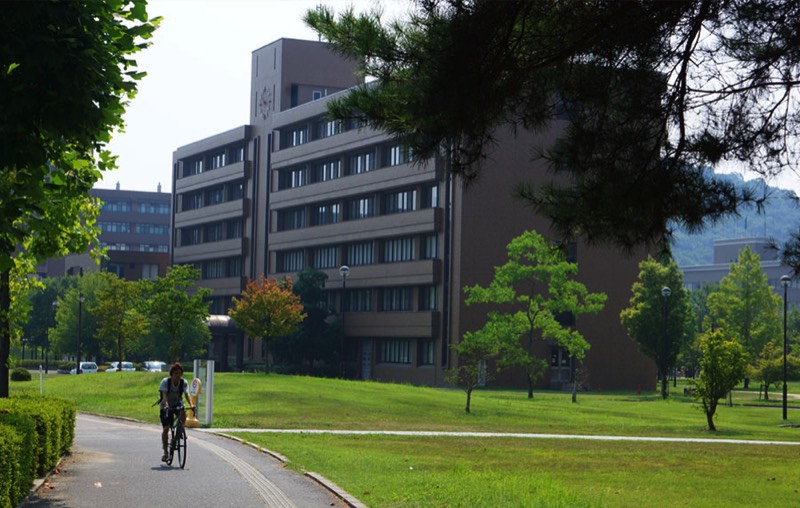
Hiroshima University. Host of the third PAHSA Short-term Program in Japan for students from Southeast Asia
China’s Peacekeeping Operations: Creative Involvement
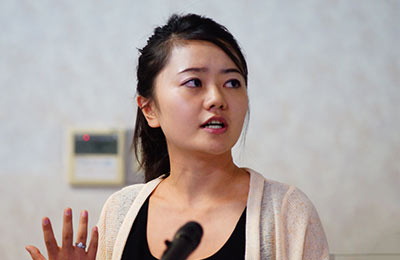
S. Rajaratnam School of International Studies, Nanyang Technological University
@Hiroshima University
As China rises, it needs to assure the world of its goodwill and intention to become a responsible power. Such diplomatic efforts help redefine China’s role in relation to the other major states, assuring the rest of the world that China’s presence is a positive one. China has begun taking action to declare its role as a responsible international actor. Becoming a more reliable stakeholder in international politics means China is increasingly willing to accept the norms and values in the delivery of international public goods, such as nuclear non-proliferation, peacekeeping and regional security.
Since the mid-1990s, China’s foreign policy has evolved to become more pragmatic and more convergent with global norms of cooperation. Its growing commitment to United Nations (UN) Peacekeeping Operations can be witnessed through efforts to increase deployment overseas, improve training capabilities, and to participate in various forms of international cooperation. China has also joined international efforts to improve the peacekeeping capabilities of relevant regional organizations and has given political and financial support to host countries. Some people attribute the changes in China’s international peacekeeping efforts to the country’s flexible interpretation of state sovereignty and the non-interference principle. However, this essay suggests that while conventional ideas about state sovereignty still persist, Chinese policymakers are taking a creative case-by-case approach while they consider China’s involvement in peacekeeping operations.
Since the mid-1990s, China’s foreign policy has evolved to become more pragmatic and more convergent with global norms of cooperation. Its growing commitment to United Nations (UN) Peacekeeping Operations can be witnessed through efforts to increase deployment overseas, improve training capabilities, and to participate in various forms of international cooperation. China has also joined international efforts to improve the peacekeeping capabilities of relevant regional organizations and has given political and financial support to host countries. Some people attribute the changes in China’s international peacekeeping efforts to the country’s flexible interpretation of state sovereignty and the non-interference principle. However, this essay suggests that while conventional ideas about state sovereignty still persist, Chinese policymakers are taking a creative case-by-case approach while they consider China’s involvement in peacekeeping operations.
China’s Creative Involvement Diplomacy
The idea of ‘creative involvement’ might be credited to the Chinese scholar, Wang Yizhou, who explained that China’s diplomatic involvement should be based on notions of peace and development, keeping in line with an important trend in international politics. Such a stance prefers a multilateral and diplomatic approach that is intended to minimize the loss for all parties involved and does not resort to power politics alone.
Important in the evolution of China’s diplomacy in recent decades, however, is that ‘creative involvement’ differs from the traditional Chinese diplomacy of ‘keeping a low profile.’ The intended objective of ‘creative involvement’ is to build a positive image of China in the international community through active participation in international activities, and, soft power projection is key to this end.
China’s position on the Darfur Question provides an important case for examining this creative involvement and is an example of where China has yielded to international pressure. Responding in large part to mounting criticism of its relations with the Sudanese government, China began exerting pressure on Sudan to allow UN and African Union peacekeepers into Darfur. China’s posture on peace enforcement in Darfur evolved from a passive position to one of mediator between the UN and Sudanese Government, eventually echoing UN statements to a certain extent. It continued its opposition to sanction in order to persuade the Sudanese government to allow the deployment of UN troops. Further, Beijing assigned a special ambassador to negotiate the terms of deployment and assisted in the conception of a concrete and workable road map to achieve success. For the first time China actively sought to persuade a sovereign government to assent to the deployment of blue helmets by seeking common grounds and practical results.
In addition to considering national interests and its own capabilities, China’s policy towards UN peacekeeping is determined by its evolving perception of the international security environment. Enhanced national strength has provided China with adequate human and material resources for a more active participation in UN peacekeeping. Yet, at the same time, that strength has also given China more confidence that has enabled it to be selectively active in international affairs, despite its long-held strategy of keeping a low profile.
However, there are some barriers that can discourage China and force it to keep a low international profile. Such discouragement includes mainstream speculation over perceived Chinese ‘interests’ in participating in international peacekeeping.
It has been suggested that China’s motives are to protect its oversea economic and energy interests only. The fact is, with the exception of Sudan, China’s peacekeeping deployments have been in countries with which it has little substantial trade relations. Yet, it is arguably the case that the goodwill generated by China’s involvement in peacekeeping, combined with the presence of other Chinese troops under bilateral and regional agreements, can also facilitate economic relationships with local governments. Beijing’s willingness to consider active participation in UN peacekeeping in the future therefore does not merely depend on China’s capabilities or willingness, but also on the sincere attitude and encouragement by others of its active participation, blanket skepticism from the international community will not help in this regard.
Important in the evolution of China’s diplomacy in recent decades, however, is that ‘creative involvement’ differs from the traditional Chinese diplomacy of ‘keeping a low profile.’ The intended objective of ‘creative involvement’ is to build a positive image of China in the international community through active participation in international activities, and, soft power projection is key to this end.
China’s position on the Darfur Question provides an important case for examining this creative involvement and is an example of where China has yielded to international pressure. Responding in large part to mounting criticism of its relations with the Sudanese government, China began exerting pressure on Sudan to allow UN and African Union peacekeepers into Darfur. China’s posture on peace enforcement in Darfur evolved from a passive position to one of mediator between the UN and Sudanese Government, eventually echoing UN statements to a certain extent. It continued its opposition to sanction in order to persuade the Sudanese government to allow the deployment of UN troops. Further, Beijing assigned a special ambassador to negotiate the terms of deployment and assisted in the conception of a concrete and workable road map to achieve success. For the first time China actively sought to persuade a sovereign government to assent to the deployment of blue helmets by seeking common grounds and practical results.
In addition to considering national interests and its own capabilities, China’s policy towards UN peacekeeping is determined by its evolving perception of the international security environment. Enhanced national strength has provided China with adequate human and material resources for a more active participation in UN peacekeeping. Yet, at the same time, that strength has also given China more confidence that has enabled it to be selectively active in international affairs, despite its long-held strategy of keeping a low profile.
However, there are some barriers that can discourage China and force it to keep a low international profile. Such discouragement includes mainstream speculation over perceived Chinese ‘interests’ in participating in international peacekeeping.
It has been suggested that China’s motives are to protect its oversea economic and energy interests only. The fact is, with the exception of Sudan, China’s peacekeeping deployments have been in countries with which it has little substantial trade relations. Yet, it is arguably the case that the goodwill generated by China’s involvement in peacekeeping, combined with the presence of other Chinese troops under bilateral and regional agreements, can also facilitate economic relationships with local governments. Beijing’s willingness to consider active participation in UN peacekeeping in the future therefore does not merely depend on China’s capabilities or willingness, but also on the sincere attitude and encouragement by others of its active participation, blanket skepticism from the international community will not help in this regard.
Conclusions
How will China engage in future international peacekeeping operations? With constraints both internally and externally, China will most likely continue to be cautious and selective based on its perceptions of international security. Notwithstanding, since the 1990s, China’s growing engagement in international affairs has exposed it to international norms and values concerning human rights and conflict resolution that are gaining traction in its foreign policy discourse. It is increasingly clear that China’s options will be shaped in the process of interacting with other players. When there have been broad international consensus regarding a specific intervention, such as in the case of Durfur, China has tended to lend its support with creative involvement, rather than be viewed as obstructionist. It is in this case that international interactions can alter China’s foreign policy calculus to the extent that China has to moderate its support for preserving state sovereignty. If China is able to think out of the box and start to seek more common areas to cooperate with Japan regarding the non-traditional security issues, then Sino-Japan relations might be softened and will be heading in the right direction.
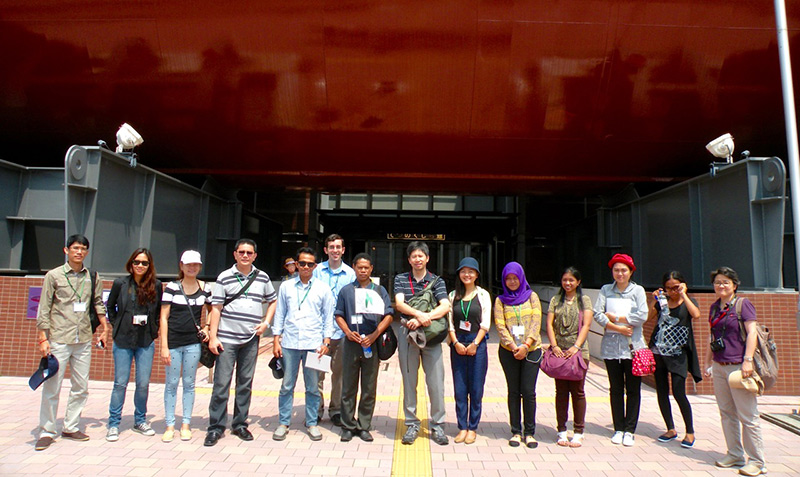
Students and professors out on a field trip
Mindanao: Striving for Peace in the 21st Century
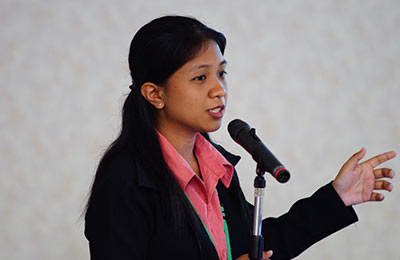
De La Salle Unviersity, the Philippines
@Hiroshima University
One of the major concerns of the Philippines when it comes to human security is the number of internal conflicts it has experienced since the end of the Second World War. Communist insurgencies, secessionist movements, and acts of terrorism have been led by powerful groups in the country, and this has resulted in a number of deaths and substantial financial losses in the affected areas.
In the past years, negotiations and peace talks were attempted by the Philippines Government, and even the international community took an interest in conflict resolution in the Southern Philippine region as they became aware of the growing need for peace and human security assistance there. Despite all attempts by the Philippine government and to a certain extent the international community, the path towards peace in Mindanao is still a rocky one. For decades, the various frameworks and agreements that were used to pacify the armed groups in Mindanao were either proven ineffective, or effective for only a short time before crumbling. This can lead us to question the effectiveness of the actions of the Philippines government in its effort for conflict resolution and whether there is a need for more active third party mediation to finally end this conflict.
In the past years, negotiations and peace talks were attempted by the Philippines Government, and even the international community took an interest in conflict resolution in the Southern Philippine region as they became aware of the growing need for peace and human security assistance there. Despite all attempts by the Philippine government and to a certain extent the international community, the path towards peace in Mindanao is still a rocky one. For decades, the various frameworks and agreements that were used to pacify the armed groups in Mindanao were either proven ineffective, or effective for only a short time before crumbling. This can lead us to question the effectiveness of the actions of the Philippines government in its effort for conflict resolution and whether there is a need for more active third party mediation to finally end this conflict.
The Mindanao Conflict
There are many different explanations regarding the cause of the conflict in Mindanao and how it may have escalated. The displacement of the Muslims, a religous minority in a predominatly Christian country, could be one reason the people of Mindanao might lack a sense of unity with the Filipinos from the North. Looking back on the history of the Philippines from the Spanish Era, it is apparent that the differences between the culture and traditions of the Northern Philippines and its Southern part were created during the Spanish Colonialization of the islands in the North (Luzon and Visayas) as the Muslims settled in the South (Mindanao). Even in the period of the American Occupation of the Philippines, the sultans and datus refused to accept Pax Americana (American Peace).
On 18 March 1968, the Jabiddah Massacre, the killing of about thirty Muslim trainees believed to have been recruited for a mission to Sabah by their superiors on the island of Corregidor, was viewed by some as an act of religious persecution. This event is widely seen to be the trigger of the long-term armed conflict and tension which has continued to this day. Various armed Muslim groups that aspire for self-determination of the Muslim Mindanao were formed after that. These were: the Muslim Independence Movement (later renamed Mindanao Independence Movement) headed by Cotabato Province Governor Datu Udtog Matalam; the Bangsa Moro Liberation Organization headed by the member of the House of Representatives Raschid Lucman; the Moro National Liberation Front headed by Nur Misuari; and the New MNLF or the Moro Islamic Liberation Front headed by Hashim Salamat. Not all these groups have always been active, but since their formation, two, the MNLF and the religious MILF, have been continuously fighting for their cause. From the groups that have been mentioned, the Moros are Muslims in Mindanao who do not feel that they share the same identity with the majority of the Filipinos. The Bangsamoro or Land of the Moros is the area or region that includes parts of Mindanao (in the extreme, this would include Palawan from Luzon and the whole of Mindanao).
On 18 March 1968, the Jabiddah Massacre, the killing of about thirty Muslim trainees believed to have been recruited for a mission to Sabah by their superiors on the island of Corregidor, was viewed by some as an act of religious persecution. This event is widely seen to be the trigger of the long-term armed conflict and tension which has continued to this day. Various armed Muslim groups that aspire for self-determination of the Muslim Mindanao were formed after that. These were: the Muslim Independence Movement (later renamed Mindanao Independence Movement) headed by Cotabato Province Governor Datu Udtog Matalam; the Bangsa Moro Liberation Organization headed by the member of the House of Representatives Raschid Lucman; the Moro National Liberation Front headed by Nur Misuari; and the New MNLF or the Moro Islamic Liberation Front headed by Hashim Salamat. Not all these groups have always been active, but since their formation, two, the MNLF and the religious MILF, have been continuously fighting for their cause. From the groups that have been mentioned, the Moros are Muslims in Mindanao who do not feel that they share the same identity with the majority of the Filipinos. The Bangsamoro or Land of the Moros is the area or region that includes parts of Mindanao (in the extreme, this would include Palawan from Luzon and the whole of Mindanao).
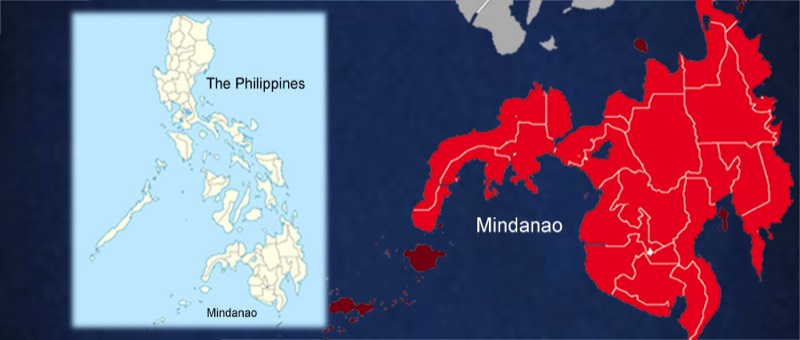
Striving for Peace
Over the years, several talks and agreements have been decided upon by the Philippine government and the MNLF to avoid escalation of conflicts. This resulted in the creation, and later the expansion, of the Autonomous Region of Muslim Mindanao (or ARMM). Though this somehow resolved certain issues with the MNLF, Philippine forces continued an armed struggle with the group. After the all-out-war policy of President Ejercito Estrada in 2000, President Gloria Macapagal-Arroyo declared an all-out-peace policy towards the Moros during her term which started in 2001. There was a ceasefire agreement between the parties and the ARMM’s territory again expanded. However, conflict rose again when the Philippine military inundated MILF territories in search of criminal elements some time later.
Last year, the government presented the 2012 Framework Agreement on the Bangsamoro to the Moro rebels (MILF). It was argued that this framework would be successful as it was so far the most ‘appropriate’ framework, and possibly the long-awaited solution for the Mindanao Conflict. Unlike previous frameworks (ex: ARMM) it recognises the rights of all the indigenous people and minorities in Bangsamoro and it has a Bangsamoro Transition Commission whose members represent the Bangsamoro constituencies. However, despite these things, a sizable armed conflict between the Moros and the Philippine Armed Forces arose once more. This time though, it was not with the MILF, but the MNLF. MNLF leader, Nur Misuari, declared the region of Bangsamoro as independent (a new sovereign state he called the Bangsamoro Republik) and refused to let Bangsamoro be recognized as an entity under the Philippine government.
Last year, the government presented the 2012 Framework Agreement on the Bangsamoro to the Moro rebels (MILF). It was argued that this framework would be successful as it was so far the most ‘appropriate’ framework, and possibly the long-awaited solution for the Mindanao Conflict. Unlike previous frameworks (ex: ARMM) it recognises the rights of all the indigenous people and minorities in Bangsamoro and it has a Bangsamoro Transition Commission whose members represent the Bangsamoro constituencies. However, despite these things, a sizable armed conflict between the Moros and the Philippine Armed Forces arose once more. This time though, it was not with the MILF, but the MNLF. MNLF leader, Nur Misuari, declared the region of Bangsamoro as independent (a new sovereign state he called the Bangsamoro Republik) and refused to let Bangsamoro be recognized as an entity under the Philippine government.
Third Party Mediation
Although there are a number of countries that support the Mindanao peace process, perhaps Malaysia is the most ‘active.’ ASEAN counties (Association of South East Asian Nation) have been known for practicing its ‘norm’ of non-intervention especially when it comes to the internal conflicts of ASEAN members. However, the spill-over effects from the Mindanao conflict is affecting Malaysia. Hundred of thousands of refugees and illegal migrants cross Malaysian borders at the Bangsamoro Republik of Nur Misuari which extends to Sabah.
Those on the outside have suggested that their intervention through mediation might help pacify existing armed conflicts between the Bangsamoro and the Philippine government. However, it would be difficult for this action to completely resolve the problem. In the main, while tackling the conflict, talks and mediation are usually resonsonsive devices. Although these can result in ceasefires, long-term peace does not hold. A deeper strategy is needed to pacify the supporters of the Bangsamoro Republik and to build a peace that will be long-lasting.
Those on the outside have suggested that their intervention through mediation might help pacify existing armed conflicts between the Bangsamoro and the Philippine government. However, it would be difficult for this action to completely resolve the problem. In the main, while tackling the conflict, talks and mediation are usually resonsonsive devices. Although these can result in ceasefires, long-term peace does not hold. A deeper strategy is needed to pacify the supporters of the Bangsamoro Republik and to build a peace that will be long-lasting.
One such strategy has already been presented by the Philippine government, the “disarmament, demobilization, and rehabilitation” of Mindanao. The Moro rebels viewed this as equal to a surrender. This never worked because no incentives for the rebels were offered. However, it might have been good for the Bangsamoro on one level, demiltarizion. This would lend focus on economic improvement (since one of the arguments behind their movement is poor economic conditions). However, rebels might argue that this kind of action would result in further conflict as the strategy would be one-sided. The character of the rebel leaders should also be considered. Writing on the cause of the Mindanao conflict, Professor Rizal Buendia states that it is not only religious concepts that drive the hostilities, but it is the will and personal aspirations of the leader (or leaders) heading various movement.
I think, just like as in the case of GAM (Gerakan Aceh Merdeka) in Aceh, Indonesia, where support for geurilla organizations was fitful, not all the people in the area of the Bangsamoro Republik agree with the proposed principles/values of Nur Misuari. Perhaps examining and rethinking this fact could be a good basis to build a lasting solution for the Mindanao Conflict.
For more information about the Southern Philippines, please visit or sister site, Asia Peacebuilding Initiatives and read the P's Pod's Southern Philippines special.
I think, just like as in the case of GAM (Gerakan Aceh Merdeka) in Aceh, Indonesia, where support for geurilla organizations was fitful, not all the people in the area of the Bangsamoro Republik agree with the proposed principles/values of Nur Misuari. Perhaps examining and rethinking this fact could be a good basis to build a lasting solution for the Mindanao Conflict.
For more information about the Southern Philippines, please visit or sister site, Asia Peacebuilding Initiatives and read the P's Pod's Southern Philippines special.
PAHSA is part of "Campus Asia." Supported by the Ministry of Education, Culture, Sports, Science and Technology in Japan
Download the PAHSA Brochure
PAHSA sister sites
.gif)


